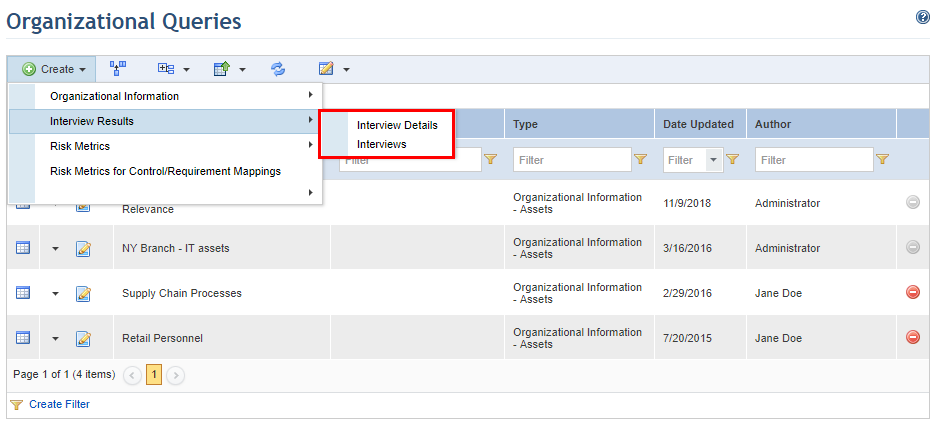
This topic explains how to create queries to view interview statistics, available through the Organization module. In this type of query, you must select one or more completed interviews in addition to selecting the organizational projects, in order to view responses and other information on them.
1. Access the Organization module.
2. In the Queries section, click the List Queries option.
3. In the Organizational Queries section, click Create.
4. Select the Interview Results option and click Interview Details or Interviews (see figure below).

The system displays the Scope step in the wizard for creating queries, where the projects and interviews you want to query can be selected (see figure below).
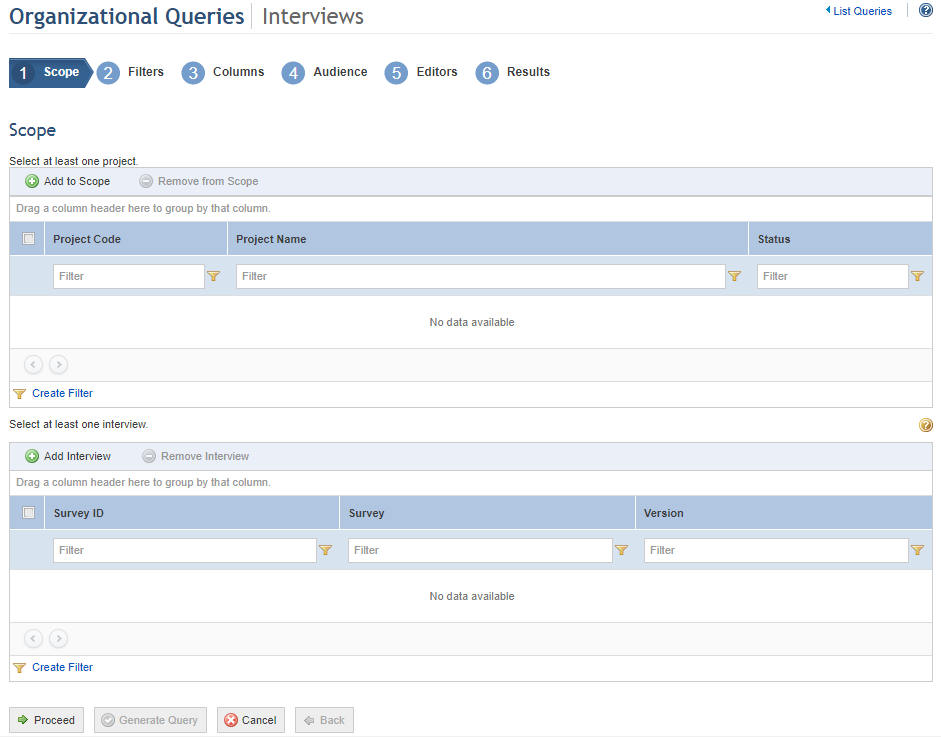
5. Click Add to Scope to select the projects you want to include in the scope.
6. Select one or more projects in the window that appears and click Add to Scope (see figure below). If you want to quit the operation, click Cancel.
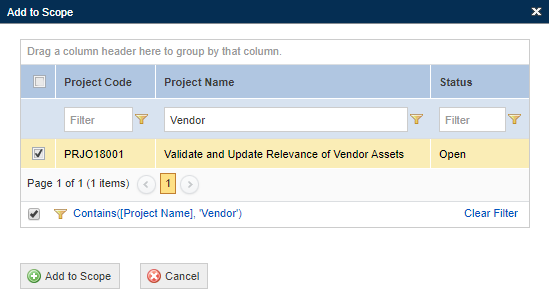
7. Click Add Interview to select the interviews you want to query.
8. In the window that appears, select one or more interviews to be added to the scope. Click Add Interview to include the interviews in the scope of the query. If you want to quit the operation, click Cancel. Keep in mind that only completed interviews will be available for selection.
9. When finished selecting the scope, click Proceed to continue creating the query. If you want to generate the query, click Generate Query. If you want to cancel query creation, click Cancel.
When Proceed is clicked, the system displays the Filters step, where the filters to be used can be selected (see figure below).

10. Select the filter you want to use by clicking the filter options listed on the left (see figure below).
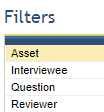
Note: These queries can be filtered by asset, interviewee, question, and reviewer. Selecting a filter in this type of query means indicating which statistics and responses will be displayed in the query results. For example, if you filter the query to show only those which Mary reviewed, this means that only interviews reviewed by Mary will be used to generate the query results.
11. Depending on the filter option selected, mark the checkboxes next to the objects to be added to the filter or click Add to Filter to select the objects that will be used to filter the scope of the query (see figure below). Note that the options available vary depending on the type of filter you choose.
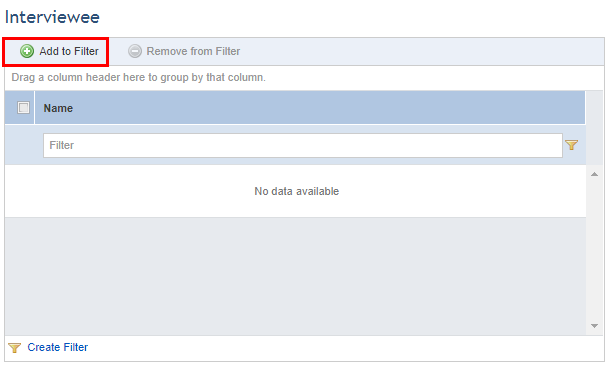
12. Select the objects to be added to the filter in the window that appears and click Add Selected (see figure below). If you want to quit the operation, click Cancel.
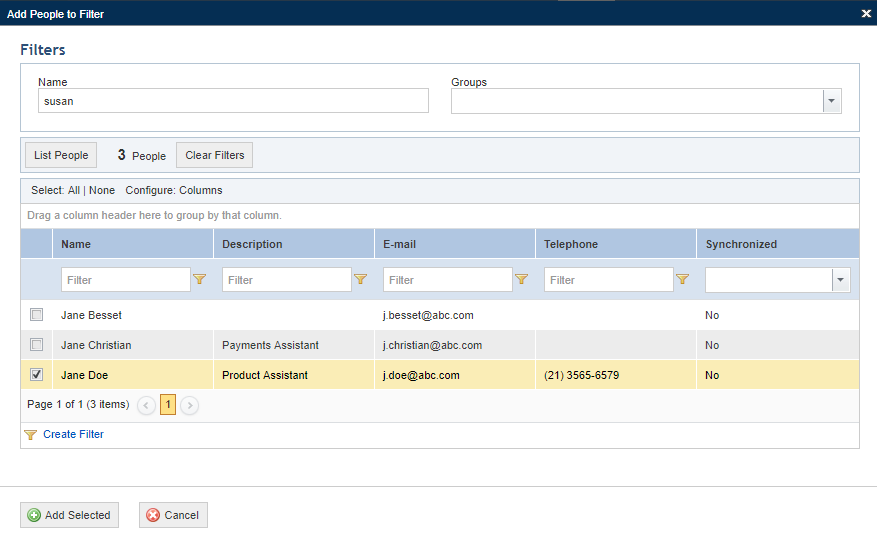
The system displays the objects selected for the filter.
13. To remove objects added to the filter, mark the checkboxes next to each object you want to remove and click Remove from Filter.
14. After selecting the filters, click Proceed to continue creating the query. If you want to generate the query, click Generate Query. If you want to cancel query creation, click Cancel. To return to the previous step at any point during this wizard, click Back.
When Proceed is clicked, the system displays the Columns step, where the columns to be displayed in the query results can be selected (see figure below).
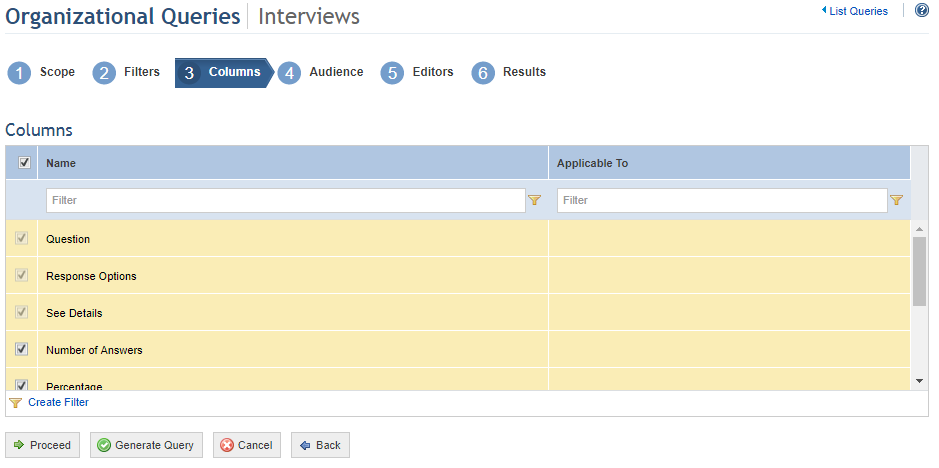
15. Select the columns you want to include in the query results by marking the checkboxes next to each. By default, the system will show some pre-selected options that can be removed, while others are required columns. To include or remove optional columns in the results, simply mark or unmark the checkboxes next to their names.
16. Click Proceed to continue creating the query. If you want to generate the query, click Generate Query. If you want to cancel query creation, click Cancel. To return to the previous step at any point during this wizard, click Back.
When Proceed is clicked, the system displays the Audience step, where you can select which people and groups will be able to view the query in the Home module and in this module, if they have permission to access it (see figure below).
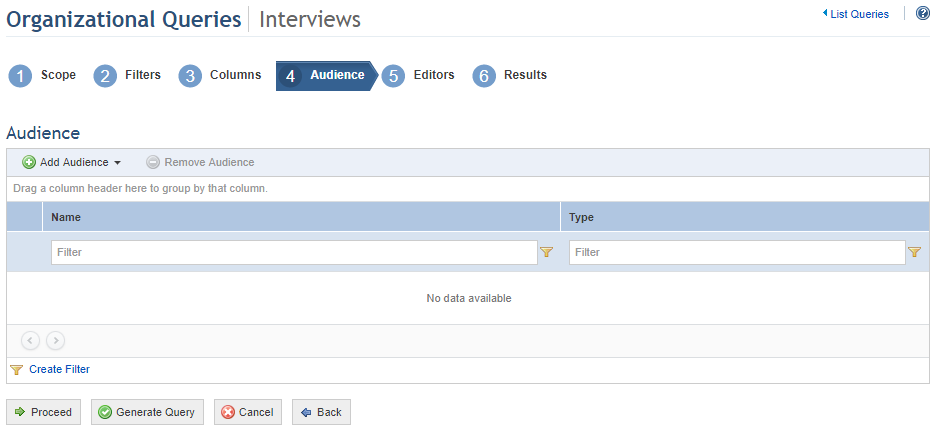
17. Click Add Audience and select People or Groups to add them.
18. If, for example, you selected People, select the people to be added and click Add People (see figure below). If you want to quit the operation, click Cancel.
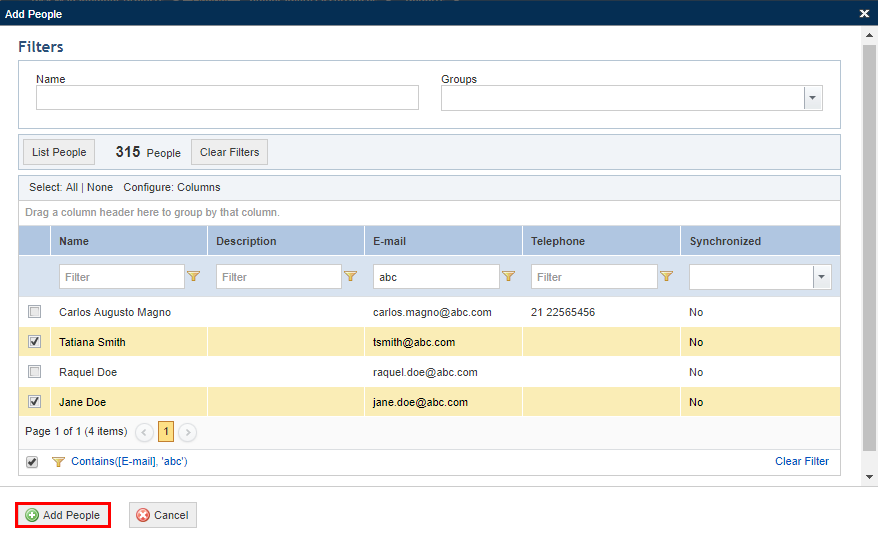
The system displays the people selected.
19. To remove people or groups from the audience, mark the checkboxes next to their names and click Remove Audience.
The system requests confirmation to remove the people or groups from the audience (see figure below).
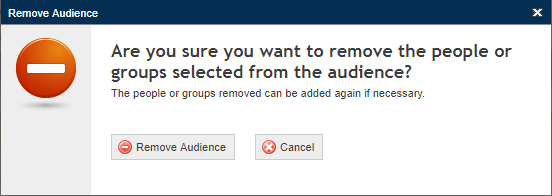
20. Click Remove Audience to confirm. If you want to quit the operation, click Cancel.
The system removes the people selected from the audience.
21. Click Proceed to continue creating the query. If you want to generate the query, click Generate Query. If you want to cancel query creation, click Cancel. To return to the previous step, click Back.
When Proceed is clicked, the system displays the Editors step, where you can select which people and groups will be able to edit the query, receiving the same permissions to it as the author (see figure below).
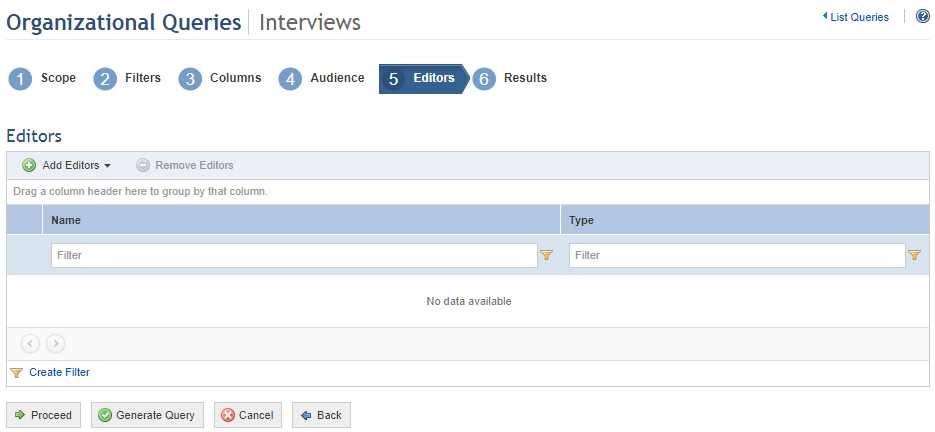
22. Click Add Editors and select People or Groups to add them to the list of editors.
23. If, for example, you selected People, select the people to be added and click Add People (see figure below).

The system displays the people selected.
24. To remove people or groups from the list of editors, mark the checkboxes next to their names and click Remove Editors.
The system requests confirmation to remove the people or groups from the list of editors (see figure below).
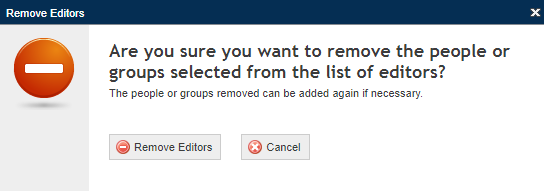
25. Click Remove Editors to confirm. If you want to quit the operation, click Cancel.
The system removes the people selected from the list of editors.
26. Click Proceed or Generate Query to run the query. If you want to cancel query creation, click Cancel. To return to the previous step, click Back.
When Proceed is clicked, the system displays the results of the query according to what was selected in the previous steps (see figure below).
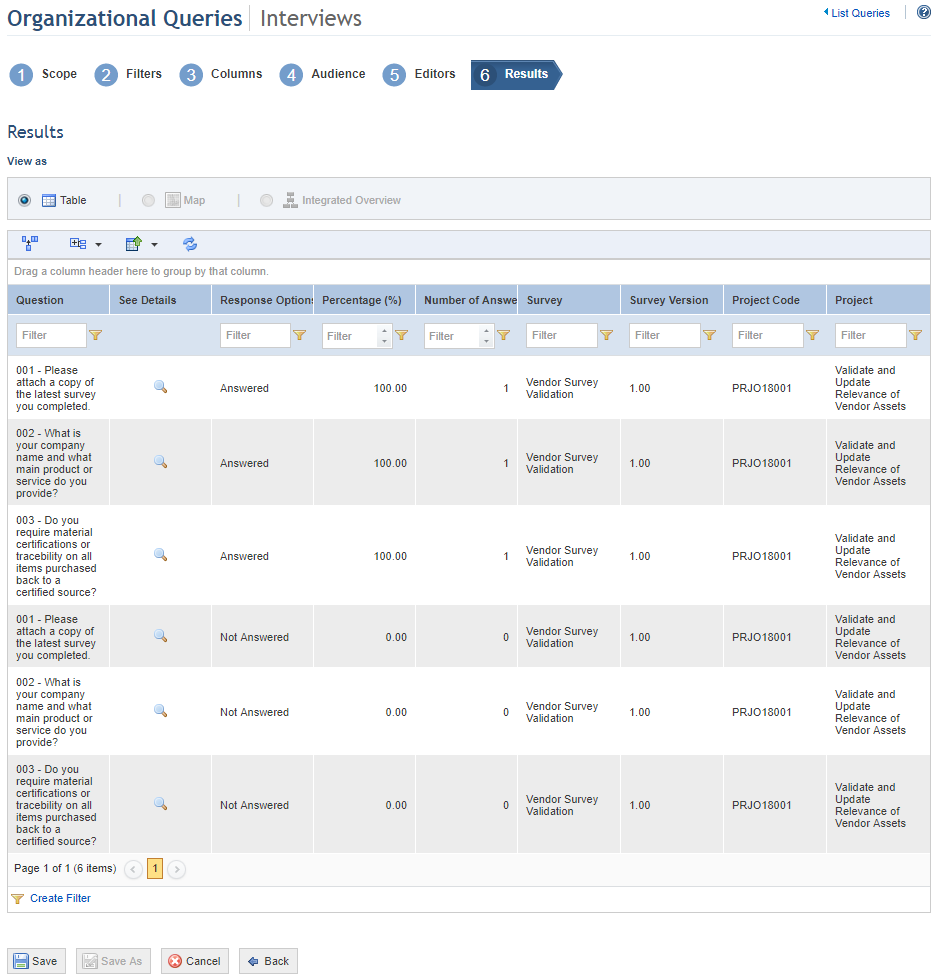
Note: You can group the results by question to view all the response options and their statistics for each interview question.
27. For
Interview queries, when See Details ( )
next to a question is clicked, a window appears showing the details for the
response selected (see figure below).
)
next to a question is clicked, a window appears showing the details for the
response selected (see figure below).
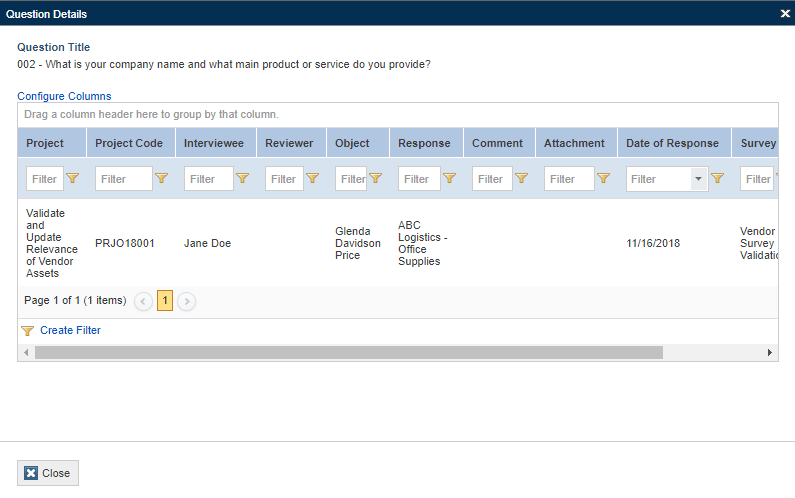
Note: In Interview Details
queries, the main results page displays all the information that is only
available in Interview queries by clicking See Details ( ).
).
28. Click Close when finished viewing the question details.
29. When finished creating the query and viewing its results, click Save to save the query data. If you do not want to save the query, click Cancel. To return to the previous step, click Back.
When Save is clicked, the system displays a window where a name and description for the query can be entered (see figure below).
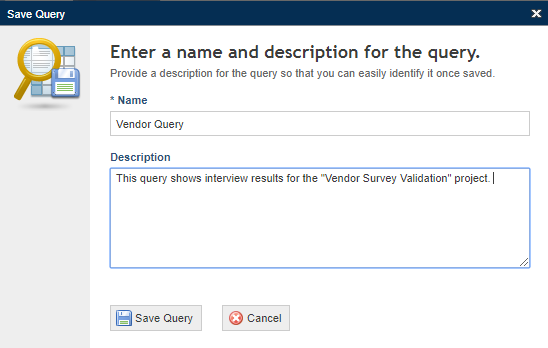
30. In the Name field, enter a name to identify the purpose and reach of the query.
31. In the Description field, enter the main characteristics of the query.
32. When finished, click Save Query. If you want to quit the operation, click Cancel.
The system displays a success message.